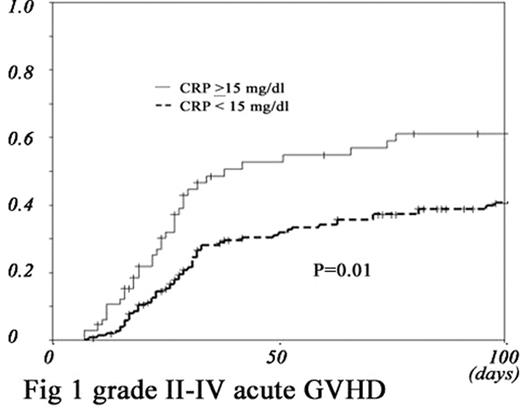Abstract
Background: In a mouse model, it has been shown that inflammatory cytokines play a primary role in the development of acute graft-versus-host disease (GVHD). Here, we evaluated whether the pre-engraftment CRP value, which is used as a surrogate marker of inflammation, could predict post-transplant complications including GVHD.
Methods: The medical records of 224 adult patients (median age, 47 years; range, 18–68 y), who underwent conventional (CST, n=105) or reduced-intensity (RIST, n=119) allogeneic stem cell transplantation between January 2002 and July 2006 were reviewed retrospectively. Their diagnosis included AML (n=94), ALL (n=23), NHL (n=62), MDS (n=27) and others (n=18). Stem cell sources included bone marrow (n=108), peripheral blood stem cells (n=98) and cord blood cells (n=18). Patients were categorized according to the maximum CRP value during the pre-engraftment neutropenic period: the “low CRP” group (CRP < 15 mg/dL) included 157 patients and the “high CRP” group (CRP≥15 mg/dL) included 67 patients. We assessed the occurrence of acute GVHD, non-relapse mortality (NRM) and overall survival.
Results: The incidence of documented infections during neutropenia was higher in the high CRP group (34% vs 17%, P=0.004). The CRP value was significantly lower after RIST than after CST (P=0.017) or after related than after unrelated transplantation (P<0.001). A multiple logistic regression analysis showed that male sex, unrelated donor and HLA-mismatched donor were associated with high CRP values. The high CRP group developed significantly more grade II-IV acute GVHD, grade III-IV acute GVHD and NRM as shown in Figure 1 and 2. A multivariate analysis showed that a high CRP level was associated with an increased risk of grade II-IV acute GVHD, poor OS and high NRM.
Conclusion: The present findings suggest that the CRP value may reflect the net degree of tissue damage due to the conditioning regimen, inflammation, infection and allogeneic immune reactions, all of which lead to subsequent acute GVHD and NRM. Future clinical studies to evaluate the feasibility of earlier intervention and adjustment of GVHD prophylaxis based on monitoring of the early CRP value are warranted.
Author notes
Disclosure: No relevant conflicts of interest to declare.



This feature is available to Subscribers Only
Sign In or Create an Account Close Modal